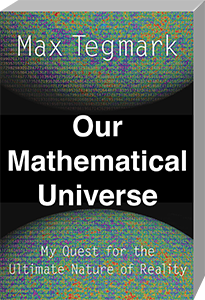Do you enjoy great detective puzzles? Do you like noticing small anomalies, and turning them into clues to an unexpected explanation? Do you like watching world-class scientists at work, piecing together insights to create new theories, and coping with disappointments when their theories appear to be disproved?
In the book “Our mathematical universe”, the mysteries being addressed are some of the very biggest imaginable:
- What is everything made out of?
- Where does the universe come from? For example, what made the Big Bang go “bang”?
- What gives science its authority to speak with so much confidence about matters such as the age and size of the universe?
- Is it true that the constants of nature appear remarkably “fine-tuned” so as to allow the emergence of life – in a way suggesting a miracle?
- What does modern physics (including quantum mechanics) have to teach us about mind and consciousness?
- What are the chances of other intelligent life existing in our galaxy (or even elsewhere in our universe)?
- What lies in the future of the human race?
The author, Max Tegmark, is a Swedish-born professor of physics at MIT. He’s made a host of significant contributions to the development of cosmology – some of which you can read about in the book. But in his book, he also shows himself in my view to be a first class philosopher and a first class communicator.
Indeed, this may be the best book on the philosophy of physics that I have ever read. It also has important implications for the future of humanity.
There are some very big ideas in the book. It gives reasons for believing that our universe exists alongside no fewer than four different types of parallel universes. The “level 4 multiverse” is probably one of the grandest conceptions in all of philosophy. (What’s more, I’m inclined to think it’s the correct description of reality. At its heart, despite its grandness, it’s actually a very simple theory, which is a big plus in its favour.)
Much of the time, the writing in the book is accessible to people with pre-university level knowledge of science. On occasion, the going gets harder, but readers should be able to skip over these sections. I recommend reading the book all the way through, since the last chapter contains many profound ideas.
I think you’ll like this book if:
- You have a fondness for pure mathematics
- You recognise that the scientific explanation of phenomenon can be every bit as uplifting as pre-scientific supernatural explanations
- You are ready to marvel at the ingenuity of scientific investigators going all the way back to the ancient Greeks (including those who first measured the distance from the Earth to the Sun)
- You are critical of “quantum woo woo” hand-waving that says that quantum mechanics proves that consciousness is somehow a non-local agent (and that minds will survive bodily death)
- You want to find more about Hugh Everett, the physicist who first proposed that “the quantum wave function never collapses”
- You have a hunch that there’s a good answer to the question “why is there something rather than nothing?”
- You want to see scientists in action, when they are confronted by evidence that their favoured theories are disproved by experiment
- You’re ready to laugh at the misadventures that a modern cosmologist experiences (including eminent professors falling asleep in the audience of his lectures)
- You’re interested in the considered viewpoint of a leading scientist about matters of human existential risk, including nuclear wars and the technological singularity.
Even more than all these good reasons, I highlight this book as an example of what the world badly needs: clear, engaging advocacy of the methods of science and reason, as opposed to mysticism and obscurantism.
Footnote: For my own views about the meaning of quantum mechanics, see my earlier blogpost “Schrödinger’s Rabbits”.
